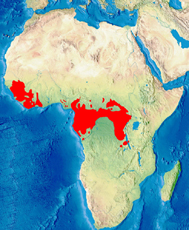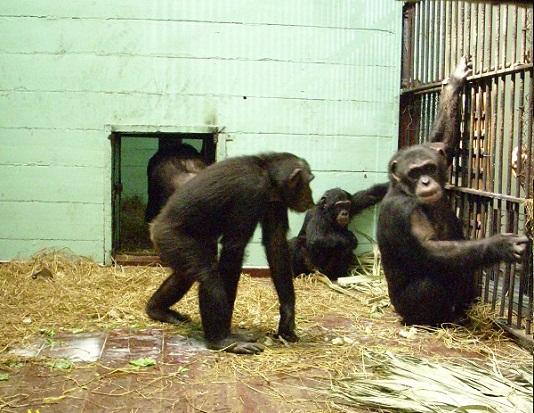Chimpanzee's Enclosure at Giza Zoo Class: Mammalia
Order: Primates
Family: Pongidae
Species: Pan troglodytes |
Pan troglodyte's subspecies and distribution:
1. Pan troglodytes verus
2. Pan troglodytes vellerosus
3. Pan troglodytes troglodytes
4. Pan troglodytes schweinfurthii
Distribution:
Populations of chimpanzees are found scattered throughout several equatorial African countries. |  |
Habitat:
Chimpanzee's habitat varies widely, including forests, open woodlands, and savannas.
Description:
Color of the coat and face varies somewhat depending on age, sex, and environment of the individual. Some old males are silver-gray with an almost totally black face, but members of these species are typically blackish brown. The ears are large and bare. Length of head and body 77-92 cm (30-36 in), standing height up to 115 cm (46 in), weight about 50kg (112lb); females slightly smaller.
Life Span:
They live for 30 years in the wild, whereas 50 years in captivity.
Diet:
In the wild, a chimpanzee's primary diet consists of fruit and other vegetation, such as leaves, flowers, and seeds. Insects make up a small portion of their diet. Chimpanzees will "fish" for termites by inserting sticks or leaves into termite mounds and eating the termites that collect on the object. Chimpanzees will also occasionally eat meat, including bushbuck, monkeys and baboons.  |
Group Chimpanzee at Giza Zoo, from Left to right Loza MeshMesh & Prince
مجموعة الشمبانزي في حديقة الحيوان بالجيزة من اليمين إلى اليسار البرنس و مشمش ولوزة |
Behavior:
Chimpanzees live in communities that typically range from twenty to more than 150 members, but spend most of their time traveling in small parties of just a few individuals.
Chimpanzee has an omnivorous diet, a troop hunting culture based on beta males led by an alpha male, and highly complex social relationships.
Chimpanzee may be found in groups of the following types: all-males, adult females and offspring, mixed sexes, one female and her offspring, or a single individual. Breeding and Care of Young:
Puberty in both sexes occurs at about 7-8 years of age, but females do not usually give birth until 13-14 years, and males are not fully integrated into the social hierarchy until they are 11 - 15 years old.
Females are capable of reproducing into their 30s and 40s.
The great apes have no 'breeding season'. Males are sexually active at all times. Females have a hormone-controlled cycle usually longer than 30 days. |
Chimpanzee estrous cycle is approximately 34 - 37 days in length, but there are tremendous individual differences. Gestation lasts 7.5 months, and females usually give birth to one young that will remain with her from 6 to 10 years.
Infants are generally tolerated by all members of the community. Females may carry or comfort infants other than their own. Males are usually tolerant of infants and may pat, touch, groom, play with, comfort, or embrace infants.
Conservation status:
IUCN Red List: Endangered.
Today's wild population is estimated to range from 100,000 to 230,000 individuals.
References:
http://en.wikipedia.org/wiki/Pan_troglodytes
http://animaldiversity.ummz.umich.edu/site/accounts/information/Pan_troglodytes.html
http://www.iucnredlist.org/apps/redlist/details/15933/0
|